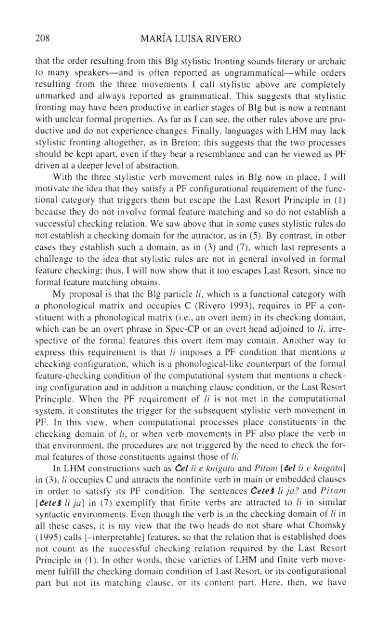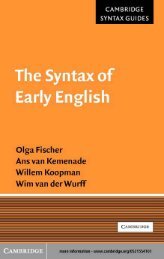Comparative Syntax of the Balkan Languages (Oxford ... - Cryptm.org
Comparative Syntax of the Balkan Languages (Oxford ... - Cryptm.org
Comparative Syntax of the Balkan Languages (Oxford ... - Cryptm.org
- No tags were found...
Create successful ePaper yourself
Turn your PDF publications into a flip-book with our unique Google optimized e-Paper software.
208 MARIA LUISA RIVEROthat <strong>the</strong> order resulting from this Blg stylistic fronting sounds literary or archaicto many speakers—and is <strong>of</strong>ten reported as ungrammatical—while ordersresulting from <strong>the</strong> three movements I call stylistic above are completelyunmarked and always reported as grammatical. This suggests that stylisticfronting may have been productive in earlier stages <strong>of</strong> Blg but is now a remnantwith unclear formal properties. As far as I can see, <strong>the</strong> o<strong>the</strong>r rules above are productiveand do not experience changes. Finally, languages with LHM may lackstylistic fronting altoge<strong>the</strong>r, as in Breton; this suggests that <strong>the</strong> two processesshould be kept apart, even if <strong>the</strong>y bear a resemblance and can be viewed as PFdriven at a deeper level <strong>of</strong> abstraction.With <strong>the</strong> three stylistic verb movement rules in Blg now in place, I willmotivate <strong>the</strong> idea that <strong>the</strong>y satisfy a PF configurational requirement <strong>of</strong> <strong>the</strong> functionalcategory that triggers <strong>the</strong>m but escape <strong>the</strong> Last Resort Principle in (1)because <strong>the</strong>y do not involve formal feature matching and so do not establish asuccessful checking relation. We saw above that in some cases stylistic rules donot establish a checking domain for <strong>the</strong> attractor, as in (5). By contrast, in o<strong>the</strong>rcases <strong>the</strong>y establish such a domain, as in (3) and (7), which last represents achallenge to <strong>the</strong> idea that stylistic rules are not in general involved in formalfeature checking; thus, I will now show that it too escapes Last Resort, since n<strong>of</strong>ormal feature matching obtains.My proposal is that <strong>the</strong> Blg particle li, which is a functional category witha phonological matrix and occupies C (Rivero 1993), requires in PF a constituentwith a phonological matrix (i.e., an overt item) in its checking domain,which can be an overt phrase in Spec-CP or an overt head adjoined to li, irrespective<strong>of</strong> <strong>the</strong> formal features this overt item may contain. Ano<strong>the</strong>r way toexpress this requirement is that li imposes a PF condition that mentions achecking configuration, which is a phonological-like counterpart <strong>of</strong> <strong>the</strong> formalfeature-checking condition <strong>of</strong> <strong>the</strong> computational system that mentions a checkingconfiguration and in addition a matching clause condition, or <strong>the</strong> Last ResortPrinciple. When <strong>the</strong> PF requirement <strong>of</strong> li is not met in <strong>the</strong> computationalsystem, it constitutes <strong>the</strong> trigger for <strong>the</strong> subsequent stylistic verb movement inPF. In this view, when computational processes place constituents in <strong>the</strong>checking domain <strong>of</strong> li, or when verb movements in PF also place <strong>the</strong> verb inthat environment, <strong>the</strong> procedures are not triggered by <strong>the</strong> need to check <strong>the</strong> formalfeatures <strong>of</strong> those constituents against those <strong>of</strong> li.In LHM constructions such as Cel li e knigata and Pitam [cel li e knigata]in (3), li occupies C and attracts <strong>the</strong> nonfinite verb in main or embedded clausesin order to satisfy its PF condition. The sentences CeteS li ja? and Pitam[ceteS li ja] in (7) exemplify that finite verbs are attracted to li in similarsyntactic environments. Even though <strong>the</strong> verb is in <strong>the</strong> checking domain <strong>of</strong> li inall <strong>the</strong>se cases, it is my view that <strong>the</strong> two heads do not share what Chomsky(1995) calls [-interpretable] features, so that <strong>the</strong> relation that is established doesnot count as <strong>the</strong> successful checking relation required by <strong>the</strong> Last ResortPrinciple in (1). In o<strong>the</strong>r words, <strong>the</strong>se varieties <strong>of</strong> LHM and finite verb movementfulfill <strong>the</strong> checking domain condition <strong>of</strong> Last Resort, or its configurationalpart but not its matching clause, or its content part. Here, <strong>the</strong>n, we have
















